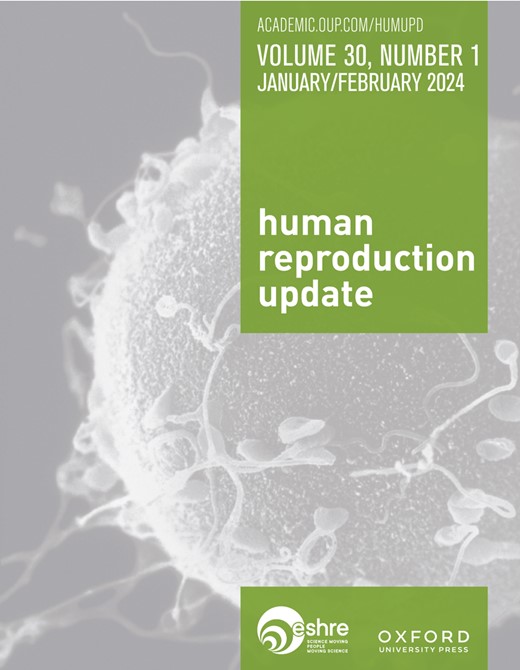精原细胞:一个独特的干细胞协调从多能性到精子产生的物种特异性转变。
IF 16.1
1区 医学
Q1 OBSTETRICS & GYNECOLOGY
引用次数: 0
摘要
男性生殖系干细胞不仅对干细胞研究人员很重要,而且对男科医生也很重要,因为它们对睾丸功能和精子发生的开始/维持至关重要。它们也被认为是男性保持生育能力的目标;例如,生殖细胞移植或睾丸移植依赖于精原干细胞(SSCs),可能很快成为恢复生育能力的临床工具。在本综述中,我们报道了精原细胞的发生,种系可塑性和精原细胞扩张模型的新见解。这些见解和一系列新的细胞和分子工具提供了巨大的技术进步和新知识,因此SSCs领域需要最新的综述。目的综述从多能前体到精子的雄性生殖系研究进展。重点介绍了近年来有关ssc产生的机制和细胞事件的最新发现。我们总结了几种物种中ssc克隆扩增的所有信息。我们重新审视旧的模型,并制定新的模型,为精子发生的初始阶段考虑物种特异性差异。具体来说,将介绍人类的情况,向读者介绍许多灵长类动物特有的特征(即自我更新祖细胞的存在,有限的减数分裂前有丝分裂步骤和小克隆大小)。这篇综述是很重要的,因为目前对人类睾丸中的精原细胞的看法需要更新,因为使用新技术(如微流体、单细胞分析和异种移植)的研究获得了新的和意想不到的发现。这些发现还需要对先前发表的结果和精原功能模型进行重新解释。检索方法我们使用PubMed和其他相关数据库来显示所有可用的信息。搜索词被灵活地组合起来。基线检索词为:精原细胞/睾丸/干细胞/有丝分裂扩增/克隆/灵长类动物/人类/精子发生/减数分裂进入/生殖细胞生态位/精子产生/生精效率。结果:男性的精子发生依赖于一个与啮齿类动物截然不同的干细胞系统。从多能性前体衍生精原细胞的研究已经在使用胚胎干细胞和诱导多能性干细胞的方法中进行了探索,并提出了一些新的概念。睾丸中有5个具有特定任务和功能的早衰生殖细胞亚群。在本文中,我们将特别关注这些特性。基于来自微环境的内部或外部刺激,通过潜在的信号和调节网络,亚种群可能表现出不同的反应。精原群体的高可塑性和可变效力可能在正常或异常种系发育过程中发挥重要而独特的作用。SSC模型是理解在减数分裂前和减数分裂阶段维持种系质量的严格检查点的有用工具。通过计算各种物种的精原细胞比率得出的证据表明,在猕猴和人类等高等灵长类动物中,克隆扩增率较慢。相比之下,在啮齿类动物等小型动物中,克隆扩张的速度更快。讨论了种系发育中这些物种特异性差异的后果。本综述还讨论了未来临床应用和新疗法的进一步选择。我们对ssc及其体细胞生态位的修订理解为男性不育的原因提供了新的视角,不仅可以为治疗行动提供策略,还可以为生育能力保存和体外产生精子的策略提供策略。本文章由计算机程序翻译,如有差异,请以英文原文为准。
Spermatogonia: a unique stem cell orchestrating species-specific transition from pluripotency to sperm production.
BACKGROUND
Male germline stem cells are relevant for stem cell researchers but also for andrologists as they are crucial for testis function and initiation/maintenance of spermatogenesis. They are also considered a target for fertility preservation in the male; e.g. germ cell transplantation or testicular grafting rely on spermatogonial stem cells (SSCs) and may soon become clinical tools to recover fertility. In the current review, we report new insights into genesis of spermatogonia, germline plasticity, and models of spermatogonial expansion. These insights and an array of novel cellular and molecular tools have provided great technological advances and new knowledge and therefore the field of SSCs needs an up-to-date review.
OBJECTIVE
In this review, we focus on the male germline starting with pluripotent precursors and ending with sperm. The recent discoveries on mechanisms and cellular events involved in the derivation of SSCs are highlighted. We summarize all information on clonal expansion of SSCs in several species. We revisit old models and formulate novel models for the initial phases of spermatogenesis considering species-specific differences. Specifically, the human situation will be presented, informing the reader on many primate-specific features (i.e. the existence of self-renewing progenitors, limited premeiotic mitotic steps, and small clonal sizes). This review is important as the current view on spermatogonia in the human testis needs an update taking in novel and unexpected findings derived from studies using new technologies, such as microfluidics, single-cell analysis, and xenografting. These findings also require re-interpretations of previously published results and models for spermatogonial function.
SEARCH METHODS
We used PubMed and other relevant databases to reveal all available information. Search terms were flexibly combined. Baseline search terms were: spermatogonia/testis/stem cell/mitotic expansion/clone/primate/human/spermatogenesis/meiotic entry/germ cell niche/sperm production/spermatogenic efficiency.
OUTCOMES
Spermatogenesis in men relies on a stem cell system which is highly distinct from that of rodents. Derivation of spermatogonia from pluripotent precursors has been explored in approaches using embryonic stem cells and induced pluripotent stem cells leading to novel concepts which are highlighted. The testis is populated with five subpopulations of premeiotic germ cells with specific tasks and functions. We will specifically focus on these features in this review. Based on the internal or external stimuli received from the microenvironment through underlying signalling and regulatory networks, subpopulations may show diverse responses. The high plasticity and variable potency of spermatogonial populations may play an important and distinct role during normal or aberrant germline developments alike. SSC models are helpful tools to understand the rigorous checkpoints maintaining germline quality at pre-meiotic and meiotic stages. Evidence from calculated spermatogonial ratios for various species indicates that clonal expansion rates are slower in higher primates like macaques and humans. In contrast, clonal expansion takes place at a faster rate in small animals like rodents. The consequences of these species-specific differences in germline development are discussed. Further options for future clinical applications and new therapies are also discussed in this review.
WIDER IMPLICATIONS
Our revised understanding of the SSCs and their somatic niches creates a novel view on the causes of male infertility and may open strategies not only for curative actions but also for fertility preservation and ex vivo strategies to generate spermatozoa.
求助全文
通过发布文献求助,成功后即可免费获取论文全文。
去求助
来源期刊

Human Reproduction Update
医学-妇产科学
CiteScore
28.80
自引率
1.50%
发文量
38
期刊介绍:
Human Reproduction Update is the leading journal in its field, boasting a Journal Impact FactorTM of 13.3 and ranked first in Obstetrics & Gynecology and Reproductive Biology (Source: Journal Citation ReportsTM from Clarivate, 2023). It specializes in publishing comprehensive and systematic review articles covering various aspects of human reproductive physiology and medicine.
The journal prioritizes basic, transitional, and clinical topics related to reproduction, encompassing areas such as andrology, embryology, infertility, gynaecology, pregnancy, reproductive endocrinology, reproductive epidemiology, reproductive genetics, reproductive immunology, and reproductive oncology. Human Reproduction Update is published on behalf of the European Society of Human Reproduction and Embryology (ESHRE), maintaining the highest scientific and editorial standards.
 求助内容:
求助内容: 应助结果提醒方式:
应助结果提醒方式:


